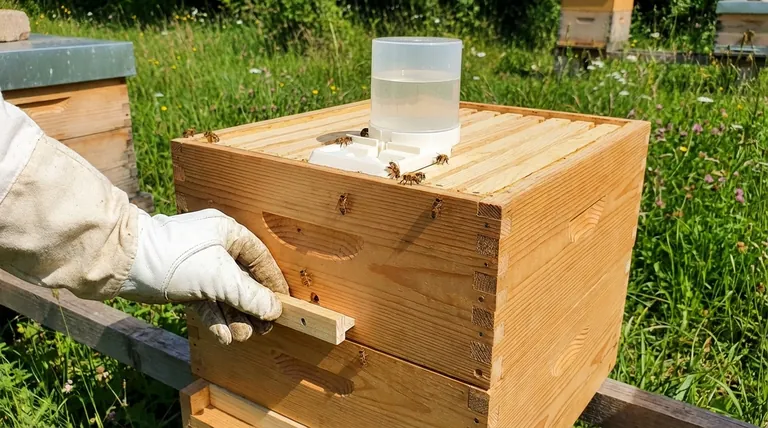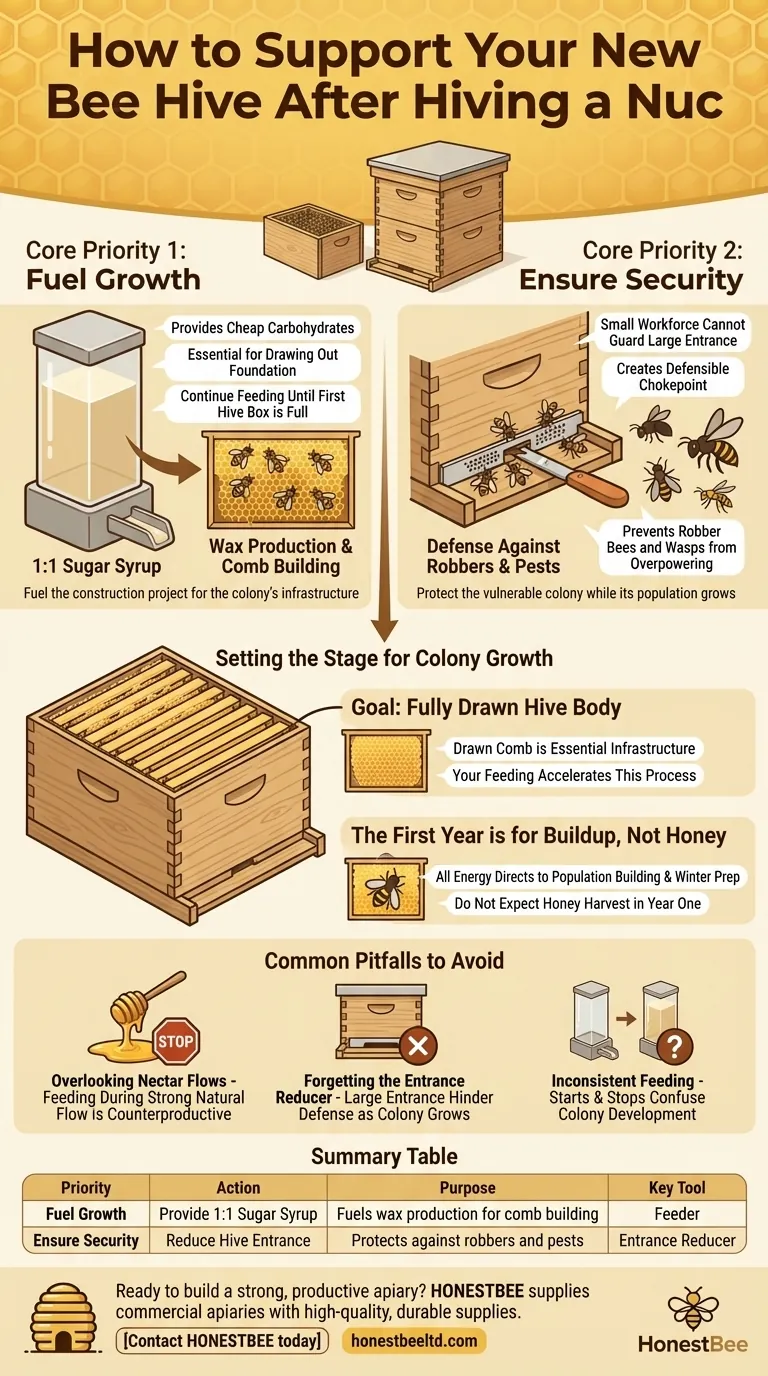To successfully establish a new hive, you must provide two critical forms of support immediately after installing a nucleus colony: a consistent food source and a reduced entrance. These actions give the small colony the fuel it needs to build its home and the security it needs to defend itself while it grows.
A newly hived nuc is like a startup company. It has a skilled team (the bees) but lacks infrastructure (drawn comb) and operating capital (food stores). Your role as the beekeeper is to provide the initial resources and security to ensure it survives and becomes self-sufficient.

The Core Priorities: Food and Defense
A young colony's energy is divided between raising new bees, building the nest, and defending its limited resources. Your support should focus on making these tasks as easy as possible.
Why Feeding is Non-Negotiable
A nucleus colony arrives with only a few frames of food. The bees' most urgent and energy-intensive task is to produce wax and "draw out" the foundation on the empty frames, creating the hexagonal cells they need for raising brood and storing food.
Producing beeswax is incredibly resource-intensive. Feeding a 1:1 sugar syrup solution provides the cheap, accessible carbohydrates the bees need to fuel this massive construction project.
Continue feeding until the bees have drawn out the comb on all the frames in their first hive box. You should also stop feeding if a major nectar flow begins, allowing them to gather natural resources.
Why a Small Entrance is Critical
A small colony has a small workforce. It cannot effectively guard a large, standard-sized hive entrance against intruders.
Robber bees from stronger, nearby hives can quickly overpower a small colony and steal all its food stores, leading to its collapse. Wasps and yellow jackets pose a similar threat.
Using an entrance reducer set to its smallest opening creates a defensible chokepoint. The colony's guard bees can easily protect this small space, ensuring the hive's security while the population grows.
Setting the Stage for Colony Growth
Your initial support is about more than just immediate survival; it's about creating the ideal conditions for the colony to expand into a strong, productive unit.
The Goal: A Fully Drawn Hive Body
A standard 10-frame Langstroth hive will contain the five frames from your nuc plus five new frames of foundation. The colony is not truly "established" until it has built comb on all ten of these frames.
This drawn comb is the essential infrastructure for the queen to lay eggs and for the workers to store pollen and nectar. Your consistent feeding directly accelerates this process.
The First Year is for Buildup, Not Honey
Do not expect a honey harvest from your new hive in its first year. All the colony's energy and resources should be directed toward building its population and preparing for its first winter.
By providing support, you help the bees build the strength and food stores necessary to survive winter without the added pressure of producing a surplus for you.
Common Pitfalls to Avoid
Even with the best intentions, new beekeepers can make mistakes that hinder a colony's progress. Understanding these risks is key to providing effective support.
Overlooking Nectar Flows
Continuing to feed sugar syrup during a strong natural nectar flow is counterproductive. The bees may choose to store the "easy" syrup in the comb instead of foraging for nectar, resulting in winter stores that lack the complex nutrients of real honey.
Forgetting the Entrance Reducer
An entrance reducer is critical for a small colony but becomes a liability for a large one. As the population explodes, a small entrance can cause traffic jams, reduce ventilation, and hinder foraging activity. Be prepared to remove it once the colony is strong and can defend itself.
Inconsistent Feeding
Starting and stopping feeding can confuse the colony's development. Provide a steady, reliable source of syrup until the comb is fully drawn. This consistency allows them to work uninterrupted on their primary construction task.
How to Apply This to Your Hive
Your specific actions should align with the primary goal of establishing a healthy, self-sufficient colony.
- If your primary focus is rapid establishment: Feed a 1:1 sugar syrup solution continuously until all frames in the first brood box are fully drawn with comb.
- If your primary focus is colony security: Install an entrance reducer on its smallest setting the moment you hive the nuc and leave it in place until the bee population is visibly booming.
- If your primary focus is preparing for winter: Ensure that once the comb is drawn, the colony has enough time and resources (natural or supplemental) to fill the equivalent of several frames with cured honey.
By providing these simple but crucial supports, you act as a steward, guiding the colony through its most vulnerable period and setting it up for long-term success.
Summary Table:
| Priority | Action | Purpose | Key Tool |
|---|---|---|---|
| Fuel Growth | Provide 1:1 Sugar Syrup | Fuels wax production for comb building | Feeder |
| Ensure Security | Reduce Hive Entrance | Protects against robbers and pests | Entrance Reducer |
Ready to build a strong, productive apiary?
Your new nucleus colony deserves the best start. At HONESTBEE, we supply commercial apiaries and beekeeping equipment distributors with the high-quality, durable supplies needed for successful hive establishment and management.
Let us be your partner in growth. We provide the reliable equipment—from feeders to entrance reducers—that helps your colonies thrive.
Contact HONESTBEE today to discuss your wholesale needs and ensure your beekeeping operation's success.
Visual Guide

Related Products
- HONESTBEE Entrance Bee Feeder Professional Hive Nutrition Solution for Beekeeping
- Professional Hive Front Entrance Bee Feeder
- HONESTBEE Professional Entrance Bee Feeder Hive Nutrition Solution
- Boardman Entrance Bee Feeder Durable Galvanized Steel and Wood Construction for Beekeeping
- Classic Boardman Entrance Bee Feeder Hive Front Feeding Solution
People Also Ask
- How do you make an entrance feeder for bees? A Guide to Safe & Effective Hive Feeding
- How to make an entrance feeder for bees? A DIY Guide for Safe & Effective Feeding
- What are the common types of honey bee feeders? Choose the Right Feeder for Your Hive
- What is a common problem with hive front feeders? Avoid Robbing Frenzies and Protect Your Hives
- What are the different types of honey bee feeders? Choose the Right Feeder for Your Hive



















